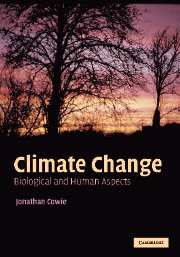Book contents
- Frontmatter
- Contents
- Introduction
- Acknowledgements
- 1 An introduction to climate change
- 2 Principal indicators of past climates
- 3 Past climate change
- 4 The Oligocene to the Quaternary: climate and biology
- 5 Present climate and biological change
- 6 Current warming and likely future impacts
- 7 The human ecology of climate change
- 8 Sustainability and policy
- Appendix 1 Glossary and abbreviations
- Appendix 2 Bio-geological chronology
- Appendix 3 Calculations of energy demand/supply and orders of magnitude
- Appendix 4 The IPCC 2007 report
- Index
- References
6 - Current warming and likely future impacts
Published online by Cambridge University Press: 17 December 2010
- Frontmatter
- Contents
- Introduction
- Acknowledgements
- 1 An introduction to climate change
- 2 Principal indicators of past climates
- 3 Past climate change
- 4 The Oligocene to the Quaternary: climate and biology
- 5 Present climate and biological change
- 6 Current warming and likely future impacts
- 7 The human ecology of climate change
- 8 Sustainability and policy
- Appendix 1 Glossary and abbreviations
- Appendix 2 Bio-geological chronology
- Appendix 3 Calculations of energy demand/supply and orders of magnitude
- Appendix 4 The IPCC 2007 report
- Index
- References
Summary
Current biological symptoms of warming
As noted in Chapter 2, climate change impacts on living species and so in turn these impacts can be used as climatic proxies. As discussed in Chapter 3, climate change throughout the Earth's history has been complex and features a number of distinct and characteristic episodes as well as periods with defining trends. However, as was observed in Chapters 3 and 4, the biological response of species and natural systems to climate change is also complex, as is the biological response of (and impact on) humans. A good proportion of this last is reflected in recorded history. Further, these impact elements – of species response and climatic-event and natural-systems response – are all discernable when applied to climate at the end of the twentieth and early twenty-first century and all exhibit varying degrees of complexity. Some responses are sufficiently complex that they appear as the opposite to what might initially be expected. Even in such cases, when examined carefully, they all clearly reflect the fact that the planet is warming up.
Current boreal dendrochronological response
One illustrative example was briefly mentioned in Chapter 2 when looking at dendrochronology. Figure 2.1 portrays the pooling together of several dendrochronological series from the northern hemisphere's high latitudes. This clearly shows that in the twentieth century the north of the northern hemisphere has warmed above the 1601–1974 average.
- Type
- Chapter
- Information
- Climate ChangeBiological and Human Aspects, pp. 231 - 309Publisher: Cambridge University PressPrint publication year: 2007



